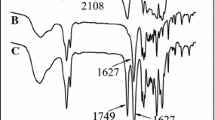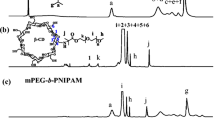Abstract
Well-defined triblock copolymers poly(N-isopropylacrylamide)-b-poly(3-methacryloxypropyltrimethoxysilane)-b-poly(N-isopropylacrylamide) (PNIPAM-b-PMEMO-b-PNIPAM) with varying block ratios were successfully synthesized via reversible addition–fragmentation chain transfer polymerization. The amphiphilic triblock copolymers showed surfactant-like behavior in aqueous solution and could easily self-assemble into dendritic micelles with hydrophobic PMEMO as the core and hydrophilic PNIPAM as the shell when the copolymer concentration exceeded the critical micelle concentration (CMC). Transmittance measurements showed the triblock copolymers were thermosensitive, and it was worth noting that the lower critical solution temperature (LCST) values of copolymers exceeded pure PNIPAM to about 35.3 °C, which was very close to physiological temperature of human body. This was attributed to the effect of Si–O–CH3 hydrolysis in polymers. The effect of a series of inorganic salts on thermosensitivity of PNIPAM-b-PMEMO-b-PNIPAM was investigated, and our results suggested that the block copolymers maintained good thermosensitivity in all salt solutions. The LCST did not change significantly in different concentrations of NaCl, CaCl2 and MgCl2 solutions, which proved the polymer had good salt resistance. Dynamic light scattering experiments showed that the micelles were well dispersed at about 120 nm below LCST with a small polydispersity index. In addition, the drug-loading experiments of micelles showed high drug encapsulation efficiency indicating their potential as drug carriers.









Similar content being viewed by others
References
Gohy JF (2005) Block copolymer micelles. Block Copolym II 190:65–136
Discher DE, Eisenberg A (2002) Polymer vesicles. Science 297:967–973
Feng Z, Lin L, Yan Z, Yu YL (2010) Dual responsive block copolymer micelles functionalized by NIPAM and azobenzene. Macromol Rapid Commun 31:640–644
Soo PL, Eisenberg A (2010) Preparation of block copolymer vesicles in solution. J Polym Sci, Part B: Polym Phys 42:923–938
Zhai C, Liu X, Yuan J, Gao Q (2013) Synthesis, characterization, and drug delivery research of an amphiphilic biodegradable star-shaped block copolymer. Polym Bull 70:419–429
Ganta S, Devalapally H, Shahiwala A (2008) A review of stimuli-responsive nanocarriers for drug and gene delivery. J Controlled Release 126:187–204
Mertoglu M, Garnier S, Laschewsky A, Skrabania K, Storsberg J (2005) Stimuli responsive amphiphilic block copolymers for aqueous media synthesised via reversible addition fragmentation chain transfer polymerisation (RAFT). Polymer 46:7726–7740
Schild HG (1992) Poly (N-Isopropylacrylamide). Experiment, theory and application. Prog Polym Sci 17:163–249
Wu C, Zhou S (1997) Volume phase transition of swollen gels. Discontinuous or Continuous? Macromolecules 30:574–576
Kujawa P, Tanaka F, Winnik FM (2006) Mesoglobules of hydrophobically-modified telechelic poly(N-isopropylacrylamides) in water probed by light scattering, fluorescence spectroscopy, and microcalorimetry. Abstr Pap Am Chem Soc 231
Wu C (1998) A comparison between the 'coil-to-globule’ transition of linear chains and the “volume phase transition” of spherical microgels. Polymer 39:4609–4619
Chung JE, Yamato M, Aoyagi T, Yokoyama M, Sakurai Y, Okano T (1998) Temperature-responsive polymeric micelles as intelligent drug carriers. Abstr Pap Am Chem Soc 216:U5–U5
Chung JE, Yokoyama M, Okano T (2000) Inner core segment design for drug delivery control of thermo-responsive polymeric micelles. J Controlled Release 65:93–103
Chung JE, Yokoyama M, Suzuki K, Aoyagi T, Sakurai Y, Okano T (1997) Reversibly thermo-responsive alkyl-terminated poly(N-isopropylacrylamide) core-shell micellar structures. Colloids Surf B 9:37–48
Wei H, Cheng SX, Zhang XZ, Zhuo RX (2009) Thermo-sensitive polymeric micelles based on poly(N-isopropylacrylamide) as drug carriers. Prog Polym Sci 34:893–910
Boyer C, Bulmus V, Davis TP, Ladmiral V, Liu J, Perrier S (2009) Bioapplications of RAFT polymerization. Chem Rev 109:5402–5436
Chiefari J, Chong YK, Ercole F, Krstina J, Jeffery J, Le TPT, Mayadunne RTA, Meijs GF, Moad CL, Moad G (1998) Living free-radical polymerization by reversible addition − fragmentation chain transfer: the RAFT process. Macromolecules 31:5559–5562
Mccormick CL, Sumerlin BS, Lokitz BS, Stempka JE (2008) RAFT-synthesized diblock and triblock copolymers: thermally-induced supramolecular assembly in aqueous media. Soft Matter 4:1760–1773
Cong HL, Li JG, Li L, Zheng SX (2014) Thermoresponsive gelation behavior of poly(N-isopropylacrylamide)-block-poly(N-vinylpyrrolidone)-block-poly(N-isopropylacrylamide) triblock copolymers. Eur Polymer J 61:23–32
Smith AE, Xu X, Mccormick CL (2010) Stimuli-responsive amphiphilic (co)polymers via RAFT polymerization. Prog Polym Sci 35:45–93
Yu Y, Hong D, Liu Z, Jia F, Zhou Y, Leng C (2013) Controllable preparation and characterization of the thermosensitive block polymers. J Polym Res 20:235
Yu Y, Li S, Leng C, Xiong T, Yuan K, Yan S, Jia F (2014) Synthesis and self-assembly behavior of thermoresponsive triblock copolymer. Polym Sci Ser B 56:191–197
Wu J, Sun X, Zhang R, Yuan S, Wu Z, Lu Q, Yu Y (2016) RAFT preparation and self-assembly behavior of thermosensitive triblock PNIPAAm-b-PODA-b-PNIPAAm copolymers. Colloid Polym Sci 294:1989–1995
Hirao A, Kato H, Yamaguchi K, Nakahama S (2002) Polymerization of monomers containing functional groups protected by trialkylsilyl groups. 5. Synthesis of poly (2-hydroxyethyl methacrylate) with narrow molecular weight distribution by means of anionic living polymerization. Macromolecules 19:242–255
Varma IK, Tomar AK, Anand RC (1987) Copolymerization of γ-methacryloxy propyl trimethoxy silane and methyl methacrylate. J Appl Polym Sci 33:1377–1388
Lai JT, Filla D, Shea R (2002) Functional polymers from novel carboxyl-terminated trithiocarbonates as highly efficient RAFT agents. Macromolecules 35:6754–6756
Yang W, Zhu L, Chen Y (2015) One-step fabrication of 3-methacryloxypropyltrimethoxysilane modified silica and investigation of fluorinated polyacrylate/silica nanocomposite films. RSC Adv 5:58973–58979
Zhang YJ, Furyk S, Bergbreiter DE, Cremer PS (2005) Specific Ion effects on the water solubility of macromolecules: PNIPAM and the Hofmeister series. J Am Chem Soc 127:14505–14510
Du KB, Wickramasinghe R, Qian XH (2010) Effects of salt on the lower critical solution temperature of poly (N-Isopropylacrylamide). J Phys Chem B 114:16594–16604
Liu LD, Kou R, Liu GM (2017) Ion specificities of artificial macromolecules. Soft Matter 13:68–80
Acknowledgements
The research was supported by the National Natural Science Foundation of China (No. 21705085) and the Open Foundation of State Key Laboratory Base of Eco-chemical Engineering (No. STHG1805).
Author information
Authors and Affiliations
Corresponding author
Ethics declarations
Conflict of interest
The authors declare that they have no conflict of interest.
Additional information
Publisher's Note
Springer Nature remains neutral with regard to jurisdictional claims in published maps and institutional affiliations.
Electronic supplementary material
Below is the link to the electronic supplementary material.
Rights and permissions
About this article
Cite this article
Wu, J., Zhai, W., Gao, X. et al. Preparation and self-assembly of thermosensitive triblock copolymers with N-isopropylacrylamide and 3-methacryloxypropyltrimethoxysilane as monomers. Polym. Bull. 78, 753–768 (2021). https://doi.org/10.1007/s00289-020-03131-5
Received:
Revised:
Accepted:
Published:
Issue Date:
DOI: https://doi.org/10.1007/s00289-020-03131-5




